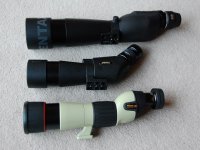As a potential newbie to the sport of bird spotting, I’m struggling to understand a few things about tripods and maybe you pros out there can help.
I chose three angled scopes that fit our budget and initial requirements, including the Nikon Fieldscope 60mm ED (3lb / 1.4kg), the Pentax 65mm ED (3.6lb / 1.6kg), and the Pentax 80mm ED (4.75lb / 2.1kg). Digiscoping may be in our future, which makes the 80mm scope a much better initial package. I have pretty much eliminated the Nikon as being too limited a package. We aren’t inclined to keep upgrading our equipment.
Then I find out that I need a $300, 6lb tripod and head to adequately hold the instrument. And regardless of the chosen scope, I don’t think it would be wise to skimp on the sturdiness of the tripod to save 1 - 2 lb of weight.
The boys at BVD extol the virtues of smaller, lighter scopes for general birding. But I struggle to see how a difference of 1.2lb (550gm) could make any difference -- unless the bigger scopes just can’t be adequately supported by a reasonably priced tripod in moderately gusting winds such as found here on our Lake Michigan shores.
Years ago I put clunky old 6 – 10lb brass surveying instruments on a bulky old wooden tripod and surveyed with reasonable precision in gusting winds with no problem. Granted, those old 10 – 12lb tripods were heavy, clumsy, and without a center rising column, but we carted them everywhere and they got the job done.
So, apparently (tripod) size and construction matters a great deal. Why?
What is it about the bigger scopes that make them more sensitive to movement on a tripod? Is it their greater exposed cross-sections exerting greater moments or torsion on an extended center stalk? If so, why use the stalk in adverse conditions?
Neglecting wilderness trekking which we don't do, we can get to most spotting sites around here with less than a ½ mile walk. I can rig a decent head on a $100, 10lb aluminum surveying tripod and be done with it, or maybe not? The cost might be the same and four to five lb of additional weight aren’t going to make any appreciable difference – especially if I have a very stable stand for my scope. Or am I trying to hit a tack with a sledge hammer, as I am want to do. Your wise counsel would be appreciated.
I chose three angled scopes that fit our budget and initial requirements, including the Nikon Fieldscope 60mm ED (3lb / 1.4kg), the Pentax 65mm ED (3.6lb / 1.6kg), and the Pentax 80mm ED (4.75lb / 2.1kg). Digiscoping may be in our future, which makes the 80mm scope a much better initial package. I have pretty much eliminated the Nikon as being too limited a package. We aren’t inclined to keep upgrading our equipment.
Then I find out that I need a $300, 6lb tripod and head to adequately hold the instrument. And regardless of the chosen scope, I don’t think it would be wise to skimp on the sturdiness of the tripod to save 1 - 2 lb of weight.
The boys at BVD extol the virtues of smaller, lighter scopes for general birding. But I struggle to see how a difference of 1.2lb (550gm) could make any difference -- unless the bigger scopes just can’t be adequately supported by a reasonably priced tripod in moderately gusting winds such as found here on our Lake Michigan shores.
Years ago I put clunky old 6 – 10lb brass surveying instruments on a bulky old wooden tripod and surveyed with reasonable precision in gusting winds with no problem. Granted, those old 10 – 12lb tripods were heavy, clumsy, and without a center rising column, but we carted them everywhere and they got the job done.
So, apparently (tripod) size and construction matters a great deal. Why?
What is it about the bigger scopes that make them more sensitive to movement on a tripod? Is it their greater exposed cross-sections exerting greater moments or torsion on an extended center stalk? If so, why use the stalk in adverse conditions?
Neglecting wilderness trekking which we don't do, we can get to most spotting sites around here with less than a ½ mile walk. I can rig a decent head on a $100, 10lb aluminum surveying tripod and be done with it, or maybe not? The cost might be the same and four to five lb of additional weight aren’t going to make any appreciable difference – especially if I have a very stable stand for my scope. Or am I trying to hit a tack with a sledge hammer, as I am want to do. Your wise counsel would be appreciated.





